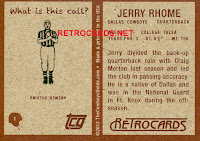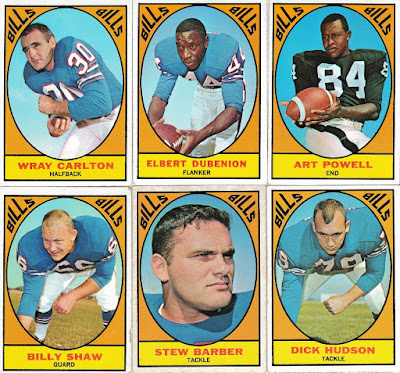A few weeks ago, I added a "League Champions" chart and a link to the Vintage Blogroll to my football card blog sidebars. This week I have added 2 more items:
1. A list of cards I still need to complete the set.
2. Under the RetroCards ad, there is a list of all the sets I have purchased from them. I highly recommend these cards to everyone. They come in sets of 9 to 25 cards (depending on the team and year), and average out to less than $2.00 per card.
-----
The Dolphins entered the AFL in 1966. For their first 4 seasons, they were coached by George Wilson (who had coached the Detroit Lions from 1957-64). During his tenure, they posted records of 3-11, 4-10, 5-8-1, and 3-10-1. In their first season, they were tied with the Oilers, but finished ahead of them on a tie-breaker.
Their last-place finish in 1969 cost Wilson his job. Don Shula was hired, and the Dolphins’ record improved immediately, to 10-4 in his first season. Miami made the playoffs in each of Shula’s first 5 seasons, making 3 trips to the Super Bowl, and winning twice. The only player below still around for the Super Bowl years was Norm Evans.
As the expansion team, the Dolphins had the first two picks in the 1966 AFL draft. Their first overall pick (fullback Jim Grabowski) signed with the Packers, but their 2nd overall pick (QB Rick Norton) started 11 of the 56 games over the team’s first 4 seasons. They also picked up WR Howard Twilley in the 12th round.
Their 1967 draft was a bit more fruitful. QB Bob Griese was selected in the 1st round (4th overall), and Jim Riley, a starter at defensive end from 1968-71, was picked in the 2nd round. They also snared their 11-year punter/tight end Larry Seiple in the 7th round. Griese made the AFL All-Star team in his first 2 seasons, and put an end to the carousel of quarterbacks used in 1966.
The Dolphins used 4 quarterbacks (George Wilson Jr, Dick Wood, Rick Norton, and John Stofa) in their first season. The veteran Wood (the Jets’ starter for 2 seasons, before the arrival of Joe Namath) and top draft pick Norton played the first few games, but soon Wilson (the coach’s son) took over, starting 7 games that year.
In 1967, Wilson was traded, Wood was let go, and everyone else grabbed a seat on the bench as Griese started 10 games, beginning his 13-year hold on that job.

Rick Norton was one of the Dolphins’ two 1st-round picks in 1966. He started as many as 5 games only once during his 4 years with the Dolphins. He also played for the Packers in 1970.
George Wilson Jr – The Bills’ 12th round pick in 1965, he saw no action that year, and was traded to the Dolphins the following summer, joining his father who was the coach. Although starting 7 games in the Dolphins’ 1st season, after Miami drafted Bob Griese in 1967 Wilson was traded to the Broncos in the Earl Faison-for-Abner Haynes deal. The Broncos released him 2 weeks later.
Joe Auer was drafted by the Chiefs in 1963, but did not play for them. After playing for the Bills from 1964-65, he joined the Dolphins in 1966. In the Dolphins’ very first game, Auer returned the opening kickoff for a touchdown. He started every game at halfback in ’66, but shared the position with Abner Haynes in ’67. He finished his career in 1968 with the Falcons.

Cookie Gilchrist played in Canada from 1954-61 as a fullback and kicker, while also playing on defense. He joined the Bills in 1962, and was the AFL’s first 1000-yard rusher, leading the league with 1096 yards in 1962, and was named Rookie of the Year. In his first 4 seasons, he led the AFL in rushing touchdowns and made the All-Star team each season.
After spending 1965 as the Broncos’ starting fullback, Cookie played 8 games (5 starts) for the Dolphins in 1966. He returned to the Broncos in 1967, but missed all but 1 game. Selected by the Bengals in the 1968 expansion draft, he retired due to a knee injury.
*Frank Jackson was drafted by the Dallas Texans in 1961. After 2 seasons on the bench, he was the Chiefs’ starting flanker from 1963-65, making the All-Star game in ’65. With 2nd-year man Otis Taylor ready to take over the flanker spot in 1966, Jackson was selected by the Dolphins in the expansion draft, and started 13 games during his 2 seasons with Miami.
Dave Kocourek was the Chargers’ starting tight end from 1960-65, making the All-Star team 4 times. He started every game for the Dolphins in 1966, then was a backup for the Raiders from 1967-68.
Billy Neighbors – The Patriots’ 6th-round pick in 1962, Neighbors started every game at right guard for 4 seasons. He was also the Dolphins’ starting right guard from 1966-68, and for part of 1969 until relinquishing that spot to Larry Little.
Norm Evans was picked by the Oilers in the 1965 draft. After 1 season on their bench, he joined the Dolphins in 1966 and started all but 4 games at right tackle from 1966-75. Evans was named to the Pro Bowl in ’72 and ’74. He also played for the Seahawks from 1976-78, starting at right tackle for the first 2 seasons.
*Ernie Park – Drafted by the Chargers in 1963, Park was a backup tackle and guard for 3 seasons. He was then the starting left guard for the Dolphins (’66), Broncos (’67), and Bengals (’68).

Earl Faison was the Chargers’ 1st-round pick in 1961, and was named Rookie of the Year. He was the team’s starting left defensive end for 5 seasons, and made the All-Star team each year, and was named first-team All-Pro 4 times. After 3 games in 1966 he was released, then hooked on with the Dolphins for the rest of the season. He did not play after 1966.
Tom Nomina – The Broncos’ 2nd-round pick in 1963, he played guard for 2 seasons until switching to defensive tackle in 1965. Nomina played his final 3 seasons (1966-68) with the Dolphins as their starting left defensive tackle (although missing 9 games in 1967). This was one of the cards in the only pack I bought in 1967.
*Rich Zecher was drafted by the Raiders in 1965. After one season, he joined the Dolphins and was their starting right defensive tackle in 1966. He split the 1967 season between Miami and Buffalo.
*Wahoo McDaniel was drafted by the Chargers in 1960, but played for the Oilers as a guard that season. For the next 5 seasons he was the starting middle linebacker for the Broncos (1961-63) and Jets (1964-65). He was the Dolphins’ right linebacker in ’66 and middle linebacker in ’67, then played 4 games as a reserve in 1968. He was also a professional wrestler from 1961-96 (which may explain why this card was the most expensive one to acquire).
Willie West was drafted by the Broncos and Cardinals in 1960. In his first 6 seasons, he played cornerback for the Cardinals (1960-61), Bills (1962-63), Broncos (1964), and Jets (1964-65). He played for the Dolphins from 1966-68, starting most games at safety in ’66 and ’68, and making the All-Star team in 1966.
Jimmy Warren – An undrafted free agent, Warren was a starting left cornerback for the Chargers (1964-65) and Dolphins (1966-69). He made the All-Star team in 1966. From 1970-77 he was a backup defensive back for the Raiders.
*Unknown to me before November 2023
As the Bengals had not yet joined the league, this post completes the 1967 AFL card set.



 Joe Namath – The first overall pick in the 1965 AFL draft, Namath quarterbacked the Jets from 1965-76 (although missing most of the games in ’70, ’71, and ’73). He made the All-Star team as a rookie, and 4 times thereafter, and led the league in passing yards in ’66, ’67, and ‘72. Namath finished up with the Rams in 1977, and was inducted into the Hall of Fame in 1985. This is the only 1967 AFL card I do not have.
Joe Namath – The first overall pick in the 1965 AFL draft, Namath quarterbacked the Jets from 1965-76 (although missing most of the games in ’70, ’71, and ’73). He made the All-Star team as a rookie, and 4 times thereafter, and led the league in passing yards in ’66, ’67, and ‘72. Namath finished up with the Rams in 1977, and was inducted into the Hall of Fame in 1985. This is the only 1967 AFL card I do not have.












.jpg)































































